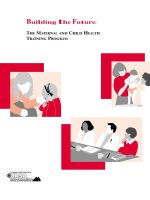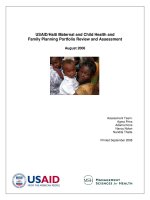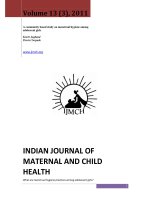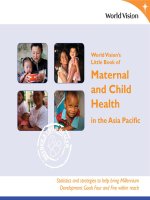Designing information support system for maternal and child health care
Bạn đang xem bản rút gọn của tài liệu. Xem và tải ngay bản đầy đủ của tài liệu tại đây (1.37 MB, 74 trang )
Addis Ababa University
School of Information Science and School of
Public Health
M.Sc. In Health Informatics Programme
Designing Information Support System for Maternal and Child
Health Care: Using Participatory Approach
By: Addisalem Bogale
A Project Submitted to School of Information Science and School of
Public Health in partial fulfillment of the requirement for the
Degree of Master of Science in Health Informatics
Addis Ababa, Ethiopia
June 2017
Addis Ababa University School of
Information Science and School of
Public Health
M.Sc. In Health Informatics Programme
Designing Information Support System for Maternal and Child Health Care:
Using Participatory Approach
By: Addisalem Bogale
A project submitted to School Information Science and School of
Public Health in partial fulfillment of the requirement for the Degree of
Master of Science in Health Informatics
Advisors _______________________________________________________
Rahel Bekele (PhD)
____________________ ____________________
Signature
Robel Yirgu (MPH)
Date
____________________ ____________________
Signature
Date
Approved by Examining Board _______________________________________
Ahmed Ali (Prof)
Examiner
Tibebe Besha (PhD)
Examiner
____________________ ____________________
Signature
Date
____________________ ____________________
Signature
Date
DEDICATION
This project work is dedicated to my beloved husband Mesfin Wondimu, my beloved son Dawit
Mesfin and the rest of my family, for their wonderful support of my work that provided me
strength, and for their patience when I have been devoted to my work for long time.
ii
ACKNOWLEDGMENT
First of all, I would like to thank the Almighty God and His mother Saint Virgin Mary for
their being with me in every aspects of my life including this project work.
Next, I would like to express my sincere and heartfelt gratitude to my advisors Dr Rahel
Bekele and Mr Robel Yirgu for their continuous support, friendly approach and invaluable
comments. They spent their precious time in commenting my work and showing me the right
directions that I found very important for the accomplishment of my project.
My deep gratitude also goes to Technology Enabled Maternal and Child Care (TEMACC)
team members for giving me their comments at various levels and ever growing kindness for
they have been positive to me all through the thesis work.
My greatest gratitude is extended to all individuals who, willingly, gave their time for the
interview in the requirement collection stage.
I would like to thank my classmates especially Tigist and Debritu for being with me
whenever in need and for their continuous encouragement during my stay in the university.
Finally, I would like to thank my beloved family, my husband Mesfin Wondimu, my
beloved son Dawit Mesfin for their love and support in all the times of my project. This
accomplishment would not have been possible without them. Thank you.
Addisalem
June 2017
iii
TABLE OF CONTENTS
DEDICATION .......................................................................................................................... ii
ACKNOWLEDGMENT.......................................................................................................... iii
LIST OF FIGURES ................................................................................................................ vii
LIST OF TABLES ................................................................................................................. viii
ABBREVIATION.................................................................................................................... ix
ABSTRACT ............................................................................................................................. xi
CHAPTER ONE ....................................................................................................................... 1
INTRODUCTION .................................................................................................................... 1
1.1 Background ..................................................................................................................... 1
1.2 Statement of the Problem ................................................................................................ 2
1.3 Objective ......................................................................................................................... 3
1.3.1 General Objective ..................................................................................................... 3
1.3.2 Specific Objectives ................................................................................................... 3
1.4 Significance of the project............................................................................................... 4
1.5 Scope ............................................................................................................................... 4
1.6 Organization of the project .............................................................................................. 4
CHAPTER TWO ...................................................................................................................... 5
LITRATURE REVIEW ............................................................................................................ 5
2.1. Maternal, Newborn and Child Health (MNCH) service utilization ............................... 5
2.2. Information Communication Technology and health care ............................................. 6
2.3. mHealth application for Maternal Newborn and Child Health ...................................... 8
2.4. Related work .................................................................................................................. 9
2.4.1 MAMA (Mobile Alliance for Maternal Action)....................................................... 9
2.4.2 Mwana ...................................................................................................................... 9
2.4.3 I‟m Expecting ......................................................................................................... 10
2.4.4 Text4baby ............................................................................................................... 10
2.4.5 Mobile Midwife ...................................................................................................... 11
2.4.6 Safe pregnancy and birth ........................................................................................ 11
iv
2.4.7 Afghanistan Mobile phone ..................................................................................... 11
2.4.8 ENAT Messenger ................................................................................................... 11
2.4. Participatory approach.................................................................................................. 12
2.5. Summary of literature review ....................................................................................... 14
CHAPTER THREE ................................................................................................................ 15
METHODOLOGY ................................................................................................................. 15
3.1 Study design .................................................................................................................. 15
3.2 Situational analysis ........................................................................................................ 15
3.3 Study area and period .................................................................................................... 16
3.4 Source and Study population ........................................................................................ 16
3.5 sampling techniques ...................................................................................................... 16
3.6 Data collection instrument ............................................................................................ 16
3.6.1 Interview ................................................................................................................. 17
3.6.2 Document Review .................................................................................................. 17
3.7 Data collection procedure.............................................................................................. 17
3.8 Data analysis ................................................................................................................. 18
3.9 Low fidelity prototype design ....................................................................................... 18
3.10 Testing and evaluation ................................................................................................ 19
3.11 Ethical clearance ......................................................................................................... 19
3.12 Methods of dissemination of results............................................................................ 19
CHAPTER FOUR ................................................................................................................... 20
RESULT AND REQUIREMENT SPECIFICATION............................................................ 20
4.1 Result............................................................................................................................. 20
4.1.1 Socio-demographic characteristics of mothers ....................................................... 20
4.1.2 Source of information on maternal and child health care ....................................... 21
4.1.3 Information technology access ............................................................................... 22
4.1.4 Interview with MNCH coordinators ....................................................................... 22
4.1.5 Discussion of result ................................................................................................ 23
4.2 Requirement analysis .................................................................................................... 24
v
4.2.1 Functional requirements ......................................................................................... 24
4.2.2 Non-functional Requirements................................................................................. 24
CHAPTER FIVE .................................................................................................................... 26
DESIGN OF SYSTEM ........................................................................................................... 26
5.1 Analysis model .............................................................................................................. 26
5.1.1 Use case modeling .................................................................................................. 26
5.1.2 Actors of the System............................................................................................... 26
5.1.3 Identified Use Cases ............................................................................................... 27
5.1.4 Use case diagram .................................................................................................... 27
5.1.5 Use Case Description.............................................................................................. 28
5.1.6 Sequence diagram ................................................................................................... 32
5.1.7 Design model .......................................................................................................... 33
5.1.8 Class diagram ......................................................................................................... 33
5.2 Design Goals ................................................................................................................. 34
5.2.2 System Architecture ............................................................................................... 35
5.2.3 Persistent Data Management .................................................................................. 35
5.3 The low fidelity prototype ............................................................................................. 36
CHAPTER SIX ....................................................................................................................... 44
TESTING AND EVALUATION ........................................................................................... 44
6.1 Introduction ................................................................................................................... 44
6.2 User profile .................................................................................................................... 44
6.3 Test environment and equipment requirements ............................................................ 44
6.4 Results of the Evaluation .............................................................................................. 46
CHAPTER SEVEN ................................................................................................................ 47
CONCLUSION AND RECOMMENDATIONS ................................................................... 47
7.1. Conclusion.................................................................................................................... 47
7.2. Recommendation for further work ............................................................................... 47
References ............................................................................................................................... 48
Annex I Information sheet ...................................................................................................... 52
vi
Annex II Consent form ........................................................................................................... 54
Annex III Interview................................................................................................................. 56
Annex IV low fidelity prototype Evaluation Questionnaire ................................................... 60
Declaration .............................................................................................................................. 62
LIST OF FIGURES
Figure 1: Use case diagram of information support system of maternal and child health............ 27
Figure 2: Search sequence diagram of information support system for MNCH .......................... 32
Figure 3: Information support sequence diagram of information support system for MNCH ..... 32
Figure 4: Login sequence diagram of information support system for MNCH ............................ 33
Figure 5: Class diagram of information support system for MNCH ............................................ 34
Figure 6: System Mobile Phone Client ......................................................................................... 35
Figure 7: Identified Tables and their Relationships of MNCH..................................................... 36
Figure 8: The application icon (A) The menu interface (B) ......................................................... 37
Figure 9 : Menu interface (A) Drop down interface (B) ............................................................... 38
Figure 10 (A) Information about first trimester (B) Menu interface ........................................... 39
Figure 11: Drop down interface (A) Information about care for child (B) ................................... 40
Figure 12: Menu interface (A) Drop down interface (B) .............................................................. 41
Figure 13: Information about care for child (A) Menu interface (B) ........................................... 42
Figure 14: Drop down interface (A) Information about care during menstrual period (B) .......... 43
Figure 15: Pictures when preparing paper proto type for testing low fidelity prototype. ............. 61
Figure 16: Pictures of mother when doing the test. ...................................................................... 61
vii
LIST OF TABLES
Table 1: Socio-demographic, language and educational status of respondents ............................ 21
Table 2: List of Actors and their Description of information support system for MNCH ........... 26
Table 3: Description of the "Browse" use case ............................................................................. 28
Table 4: Description of “Read ANC information" use case ......................................................... 28
Table 5: Description of “Read PNC information" use case .......................................................... 29
Table 6: Description of “Read Sick Child information" use case................................................. 29
Table 7: Description of “Read Hygiene information" use case .................................................... 30
Table 8: Description of “Update" use case ................................................................................... 30
Table 9: description of "Login" use case ...................................................................................... 31
Table 10: low fidelity prototype evaluation of MNCH ................................................................ 46
viii
ABBREVIATION
ACK
Acknowledgement
AMREF
African Medical and Research Foundation
ANC
Ante Natal Care
CHAI
Clinton Health Access Initiative
CHW
Community Health Worker
EDHS
Ethiopia Demographic Health Survey
EDD
Estimated Date of Delivery
FMOH
Federal Ministry of Health
FP
Family planning
GOe
Global Observatory for eHealth
GSM
Global System for Mobile Communications
HIV/AIDS
Human immune deficiency virus
Acquired Immune Deficiency Syndrome
HSTP
Health Sector Transformation Plan
ICT
Information Communication Technology
MAMA
Mobile Alliance for Maternal Action
MNCH
Mother Neonate and Child Health
mhealth
Mobile Health
MMR
Maternal Mortality Rate
MOH
Ministry of Health
MoTeCH
Mobile Technology for Community Health
OO
Object Oriented
ix
PDA
personal digital assistants
PHCU
Primary Health Care Unit
PHR
Participatory Health Research
PNC
Post Natal Care
PR
Participatory Research
SDG
Sustainable Development Goal
SMS
Short Message Service
TEMACC
Technology Enabled Maternal and Child health Care
UN
United Nations
UNICEF
United Nations International Children's Emergency Fund.
UML
Unified Modeling Language
WASH
Water Sanitation and Hygiene
WHO
World Health Organization
x
ABSTRACT
Background: In Ethiopia maternal and child mortality rate is higher due to mother's lower
access to maternal and child health care services which intern is due to their lack of information.
So many mhealth initiatives have been conducted in order to address the problem of maternal
and child health care. However, most of the projects are short lived, and the failure may be
because of absence of participation of professionals and concerned stakeholders.
Objective: The objective of this project was to design mobile application information support
system for maternal and child health care services.
Method: The study followed qualitative research in participatory approach to engage mothers
and MNCH workers in the process of the project. Primary data was collected through in depth
interview and focused group discussion during the process of the project. Secondary documents were
analyzed to obtain user requirements. Purposive sampling was used to select health centers,
mothers and MNCH coordinators. The project use selected artifacts of an object oriented system
analysis and design technique to design the low fidelity prototype.
Result: The study showed that pregnant mothers at the study area have been accessing maternal
and child health care information from national media, health related brochures, education and
advice of health workers.
Conclusion: The information support system was designed in Amharic (local language) so that it
is easy for mothers to read and understand the maternal and child care information that addresses
maternal and child health issues.
Key words: participatory approach, information support system, maternal and child health care
xi
CHAPTER ONE
INTRODUCTION
1.1 Background
The Health Sector Transformation Plan (2015) (1) states that Maternal and child mortality remains
a major challenge worldwide, though, much efforts have been undertaken for many years to address
the issues. Maternal and child health care issues are still a global health agenda. According to
United Nation report (2016) (2) one of sustainable development goals (SDGs) is accelerating the
progress made to date in reducing newborn, child and maternal mortality by ending all such
preventable deaths before 2030. This goal aims to reduce the global maternal mortality “to ensure
healthy lives and to promote well-being for all at all ages‟‟.
According to Status Report on Maternal New born and Child Health (2015) (3) 35% of neonatal
deaths worldwide are caused by preterm birth complications, 24% are caused by complications
during labor and delivery and 15% are because of sepsis. In sub-Saharan Africa and Southern Asia
many deaths are caused due to preventable infectious diseases. The Status Report on Maternal New
born and Child Health (2015) (3) also mention many neonatal deaths could be avoided with simple,
cost-effective and high-impact interventions that address the needs of women and newborns across
the continuum of care, with an emphasis on care around the time of birth. The report by World
Health Organization (WHO) (2016) (4) added, the majority of these deaths are preventable with
affordable interventions. The interventions are all women need access to ante natal care in
pregnancy, skilled care during child birth and care and support in the weeks after child birth.
It is indicated in Hiwot (2014) (5) mHealth in Ethiopia can be used to reduce maternal mortality,
because mHealth applications could allow exchange of basic health information. By using mobile
application we can improve the health of pregnant mothers by providing necessary information
about Ante Natal Care (ANC),
safe delivery, Post Natal Care (PNC), danger signs and
complications in pregnancy, and inform her when to go to health center. It can also use for other
1
services such as family planning, child immunization, and diagnosing and treating common
childhood illnesses.
The WHO report (2011) (6) states that governments are expressing interest in mHealth as
complementary strategy for strengthening health systems and achieving the health-related
Sustainable Development Goals (SDGs) in low and middle income countries. The Federal Republic
of Ethiopia Ministry of Health (2013) (7) states that combining Information and Communication
Technology (ICT) with health is one of the tools to support the health sector.
This Research project was, therefore, aimed to design mobile based information support system
using participatory approach for maternal and child health care. It helps to create awareness to
improve maternal and child health.
1.2 Statement of the Problem
The Ethiopia Demographic and Health Survey (EDHS) report (8) identified that Ethiopia is one of
the countries that have the highest maternal and child mortality rates in the world. The maternal
mortality rate of the country in the year 2016 was estimated as 353 deaths per 100,000 live births,
whereas, overall under-5 year child mortality rate was estimated as 67 per 1,000 live births in the
same year. The major causes for higher maternal mortality rate of the country have been
complications during pregnancy, delivery or postpartum period. As stated in FMOH (2015) (9)over
two-thirds of childhood deaths in Ethiopia are caused by few and easily preventable conditions;
mainly infections, neonatal conditions and malnutrition.
The Ministry of Health (2015) (10) reported that inadequate ante natal care is one causes of poor
outcomes of pregnant women in Ethiopia. Furthermore EDHS (2011) (11) mention that ANC
coverage and skill delivery of the country is very low with 34% and 10% respectively. According to
Tesfahun (2014) (12) PNC coverage of the country is also low with only 5 % of mothers received
PNC within the critical first 2 days after delivery. This indicates that in the country there are
significant obstacles in terms of access to and provision of maternal care service such as ante natal
care (ANC), postnatal care (PNC), family planning (FP), and Immunization. As mentioned in
WASH fact sheet (13) hygienic problem is also the cause of maternal morbidity and mortality in the
country by exposing them to post-partum complication and sepsis. Because of low awareness about
hygiene children are affected by diarrhea and vomiting that lead to several complication and death.
2
As states in the Ministry of Health (7) factors that prevent women from receiving or seeking care
during pregnancy and child birth are lack of information, inadequate services and cultural practices.
Other factors such as illiteracy, absence of access to technology or not being technology friendly
and other factors tend to hinder women„s health information exposure and usage. On the other
hand, information about maternal and child health care in the country are not easily accessible due
to inefficient usage of Information Technology (IT).
Challenges and opportunities of mHealth in Ethiopia indicate that (14) in Ethiopia so many mhealth
initiatives have been conducted in order to address the problem of maternal and child health care.
However, most of the projects are short lived, because of lack of community and concerned
stakeholders involvement. Moreover, Most of the activities conducted to transfer message on
mhealth have been provided in English. This resulted in lack of understanding of the message by
mothers.
Therefore, this project used participatory approach to design search and retrieval mobile application
information support system that can be easily used by mothers to access important information
related to ante natal care, post natal care, sick baby, and personal hygiene.
1.3 Objective
1.3.1 General Objective
The major purpose of this project is to: Designing information support system for maternal and child health care.
1.3.2 Specific Objectives
The specific objectives of this project are to: 1. To identify the current sources of maternal and child health care information.
2. To specify the requirement of mothers.
3. To design the mobile application information system for maternal and child health care.
4. To test the usability of the design.
3
1.4 Significance of the project
The proposed project would benefit mother's families to provide appropriate care both for herself
and for her baby. It would help Government and policy makers while preparing policy and
programs related to women and children. Besides, the project would contribute towards improving
the health and wellbeing of women, infants, children, and family. Moreover, it serves as a base for
further study of technology use to reduce maternal and child mortality.
1.5 Scope
The scope of the project is limited to design of mobile application that provide awareness about
ANC, PNC, hygiene and child care using local language (Amharic) for mothers in Addis Ababa,
Addis Ketema sub city, specifically at five selected health centers.
1.6 Organization of the project
This project is organized in seven chapters. Chapter one is the introduction part and it covers the
background the study, statement of the problem, objectives of the project, significance of the
project and scope of the project. Chapter two is the literature review; in this chapter publications
related to the use of mobile technology in health care, especially in maternal and child health care
was revived. Chapter three is about methodology used to develop this project. Chapter four is
findings and requirement analysis. Chapter five is system analysis and modeling; which talked
about the design. Chapter six talks about testing and evaluation .Chapter seven are conclusion and
recommendation.
4
CHAPTER TWO
LITRATURE REVIEW
2.1. Maternal, Newborn and Child Health (MNCH) service utilization
According to Philbrick (2013) (15) Maternal, Newborn and Child Health (MNCH) refer to abroad
health issue related to maternal and child health. Maternal health includes sexual and reproductive
health; family planning; Ante natal, perinatal, intra partum and postnatal care; delivery (midwifery);
maternal depression (psychological issues) maternal mortality (Hemorrhage, Hypertensive disorder,
HIV, Sepsis/Infection, Abortion, obstructed labor, Anemia, Ectopic pregnancy, etc. Whereas
newborn and child health includes all health conditions related to neonates, newborn, and children
less than five years of age. Most of global maternal and child morbidity and mortality has been
related to lower women's access MNCH services. Maternal health and newborn health are closely
linked, timely management and treatment can make the difference between life and death for both
the mother and the baby.
The World Health Organization (WHO) (4) recommends a minimum of four ante natal care visits
during pregnancy to ensure the well-being of mothers and newborns. At these visits, women should
receive at least a basic care package, including nutritional advice. They should also be alerted to
warning signs indicating possible problems during their pregnancy and get support in planning a
safe delivery. Central Statistical Agency also states (2016) (8), Ante natal care from a skilled
provider is important to monitor pregnancy and reduce morbidity and mortality risks for the mother
and child during pregnancy, delivery, and the postnatal period. WASH fact sheet (13) explain that
access to adequate, safe water and sanitation is important throughout pregnancy, and significantly
contributes to the well -being and health of the mother and newborn. There are many ways in which
water and sanitation contribute towards good health during pregnancy.
As mentioned in Navaneetham (16) the effect of various socio- economic, cultural and
programmatic factors are influencing the pattern of maternal health utilization in developing
countries. Lower utilization of maternal health care services among higher parity women could be
due to time and resource constraints faced by those with larger families and the greater experience
5
of higher parity women with pregnancy and child birth. Female education is a strong predictor of
use of maternal health care services. It is expected that among educated women, the decision
making power within the household, awareness, knowledge and acceptance of modern medical
treatment and health care institutions vary by their level of education.
As stated in Molla (2015) (17) in Ethiopia, maternal mortality and neonatal deaths is high. This is
mainly due to women's lower utilization of maternal and child health care services as a result of
their very low literacy levels. In addition women have been exposed to high workloads even during
pregnancy and immediately following child birth. They have low status in the household as well as
in the community. Most women have little understanding of how to take appropriate measures to
deal with prevalent diseases and health issues. Women‟s access to information from mass
gatherings or the mass media were limited. On the other hand, women‟s desire to gain access to
modern health services is hampered by difficult access (long distances and lack of transportation),
poor social status (lack of access to family money and restricted mobility), poor organization of
health services (lack of cultural sensitivity, insufficient communication, long waiting times, bribes
and verbal abuse), and Many of the rural health institutions are understaffed and lack appropriately
trained and experienced manpower. Rural women are surviving through a series of transitions
related to economic, socio-political, and demographic changes that increasingly compromises their
social and health status.
2.2. Information Communication Technology and health care
Helath states that (18) the role and importance of Information and communication technologies
(ICTs) in health care have continue to expand technological progress, expanding networks, falling
prices and growth in applications and content. ICT is the use of varies information and
telecommunication technologies such as computer, mobile phone, electronic medias, satellite etc.
for storing, sharing and retrieving data through internet, mobile phones, etc. ICTs have been used
for a wide array of purposes in the current global development. The use of ICTs in health care
which is called electronic health (eHealth) used to address different health care issues. eHealth
facilitate fast, reliable and cost effective health care services.
As mentioned in Tamrat (2012) (19), the global explosion of mobile technology has generated a
new tool to address public health challenges and shift the paradigm of health care access and
delivery. According to Kumar (2012) (20) the increase in mobile network coverage and the wide
6
expansion of low cost, and easy to use mobile phone raised the hope of accessing better health care
services even in poor regions where there is inefficient health facilities and people lack finance for
health care services. Kay (2011) (21) added, quality care and up-to-date health data are essential for
identifying health needs. Quality care means safe, effective, Patient-centered, timely, efficient and
equitable. This could be easily addressed by using technologies. The use of technology in health
care are to enhance the quality of services provided, particularly for communities in rural and
remote areas. Mobile technologies are an opportunity to improve quality of health care for women.
Furthermore, Qiang (22) states that Mobile technology has the power to upgrade the Quality of
health service especially for low income society.
According to Mechael (2009) (23) the term mobile health or mHealth, describes the use of mobile
telecommunication and multimedia technologies to meet the objectives of health care services. At
first, many eHealth initiatives in developing countries focused on computer based health
information systems and on using the Internet to promote then organization of and access to healthrelated information. Now a shift is occurring towards an ecosystem approach to using ICT for
health; this approach considers the widespread application of mobile phones. The functional and
structural properties of mobile phones make them attractive to the health sector in low- and middleincome countries. The phone‟s most notable feature is its capacity to communicate and transfer
information within both literate and illiterate populations. With the development of health-related
software applications, mobile communication technologies can provide real-time feedback, preprogrammed automated services, and support to increasingly decentralized health systems.
Meeting Health Needs (2011) (24) states that growing number of developing countries are using
mobile technology to address health needs. There is also a pressing need to improve communication
among different health units to facilitate more efficient patient care, diagnostics and treatment
support are vitally important in health care misdiagnosis or the inability to diagnose a condition
could have serious, even fatal, ramifications. mHealth applications in this area are designed to
provide diagnosis and treatment advice to remote health care workers through wireless access to
medical information databases or medical staff. With mHealth enabled diagnostics and treatment
support, patients are able to receive treatment in their villages and homes, averting the need for
expensive hospital visits, which are beyond reach for many. According to (mHelth Compendium)
the wide spread of mobile network in Africa has been addressing the health problems of Africans.
mHealth programs in Africa have contributed to innovative solutions to health system challenges
7
including: disparities in access to health services; inadequacies of health infrastructure; limited
human resources for health; cost to the individual of accessing health services; and challenges in
health financing.
2.3. mHealth application for Maternal Newborn and Child Health
United Nation Foundation (25) indicated that reaching mothers and families with simple messages
about the importance of early and exclusive breastfeeding, keeping the baby warm and dry,
recognizing the danger signs of sick newborn and avoiding practices that are harmful to newborns
can halve the rate of newborn deaths.
According to Philbrick (2013)(15) most of mHealth programs on MNCH are focused on maternal
health innervations, particularly remainder for ante natal appointment compared with newborn and
child health care innervations; short electronic massage (SMS) to improve health seeking behavior;
and mobile application for data collection. The review also added that most mHealth interventions
targeted improving skill of frontline health workers by connecting them with experienced health
professional. However, proceeding said using SMS in society where illiteracy rate is greater like
Ethiopia since it is difficult for illiterate Mothers to understand it.
Tamrat (2012) (19), reviewed 34 articles and reports of mHealth projects related to MNCH and
identified their four focus areas as emergency medical responses (urgent care during obstetric
referral) , point-of-care-support (provide maternal health care support by community workers by
communicating with skilled and experienced health professional) , health promotion (providing
information for expecting mothers through short messages) , and data collection and management .
The review showed that the use of mobile technology in the most of project areas resulted in
improved prenatal and neonatal care. It also identified that most of mHealth projects are mainly
focused on emergency care during delivery and few projects are used to intervene at multiple points
of MNCH continuum of care. Moreover, the review identified that mHealth projects designed using
local langue by involving concerned stockholders are more effective than others.
Though, there is wide expansion of mobile network in Ethiopia, utilization of mobile technology to
support health care services is minimal. It is also identified that the use of eHealth in country,
especially in rural area limited due to inefficient internet access, lack of computer and skill of
computer use by health workers (Proceeding). However, if these issues are addressed mHealth can
8









